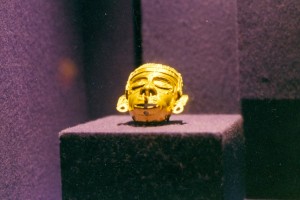 The young man’s eyes twinkled as he held up the rough carving. “It is a genuine Mayan carving” he said “I found it here in Monte Albán.” I smiled, recognizing the sales pitch, but knowing I couldn’t appear to believe it. There are still too many tourists willing to purchase artifacts and steal Mexico’s heritage. Honesty and diplomacy won. “And you must be the genuine Mayan carver” I replied. He laughed and I was soon engaged in an interesting conversation with a Oaxacan artisan who makes his living selling hand-carved souvenirs amongst the ruins of one of the most important religious and political centres in the history ofMesoamerica.
The young man’s eyes twinkled as he held up the rough carving. “It is a genuine Mayan carving” he said “I found it here in Monte Albán.” I smiled, recognizing the sales pitch, but knowing I couldn’t appear to believe it. There are still too many tourists willing to purchase artifacts and steal Mexico’s heritage. Honesty and diplomacy won. “And you must be the genuine Mayan carver” I replied. He laughed and I was soon engaged in an interesting conversation with a Oaxacan artisan who makes his living selling hand-carved souvenirs amongst the ruins of one of the most important religious and political centres in the history ofMesoamerica.
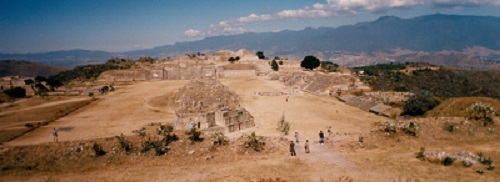 Monte Albán, also known as the “White Acropolis”, is the sacred city of the Zápotec and sits on a flattened mountaintop overlooking the Oaxaca Valley in Mexico’s southern highlands. Its origins date back to 900 B.C. when the Zápotecs first appeared in the valley. They were great city builders and artisans noted for their wonderful temples, burial chambers, pottery and metal work. The city continued as a major Zápotec political centre until it reached its zenith about A.D. 800. By this time its population of over 25,000 people resided on some 2,000 terraces located on the ridge tops and slopes of a series of low hills where a sophisticated network of dams and canals had been built in order to cultivate the fields.
Monte Albán, also known as the “White Acropolis”, is the sacred city of the Zápotec and sits on a flattened mountaintop overlooking the Oaxaca Valley in Mexico’s southern highlands. Its origins date back to 900 B.C. when the Zápotecs first appeared in the valley. They were great city builders and artisans noted for their wonderful temples, burial chambers, pottery and metal work. The city continued as a major Zápotec political centre until it reached its zenith about A.D. 800. By this time its population of over 25,000 people resided on some 2,000 terraces located on the ridge tops and slopes of a series of low hills where a sophisticated network of dams and canals had been built in order to cultivate the fields. 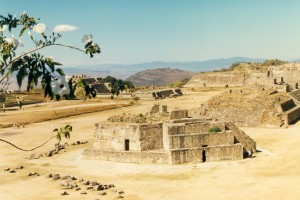 Within the city, residential communities consisting of a cluster of terraces surrounded elite homes, temples and open plazas.
Within the city, residential communities consisting of a cluster of terraces surrounded elite homes, temples and open plazas.
The centre of government, and the residence of the ruling family, was in the main plaza complex which was where I was now standing. You cannot help but be struck by its enormity. In the hot, bright sun, I could appreciate the sheer back-breaking labour that must have gone into literally cutting off the top of the mountain to create this surface for buildings that are amongst the largest pre-Hispanic structures to be found anywhere in Mesoamerica. Twenty pyramid platforms face onto an open plaza some 985 feet by 656 feet. Among the structures are 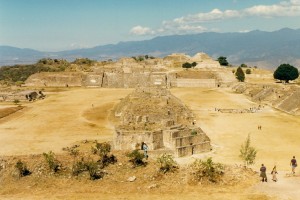 massive platforms, defining the plaza’s north and south edges, which are actually on an east/west axis, and respectively honour the sun and the moon.
massive platforms, defining the plaza’s north and south edges, which are actually on an east/west axis, and respectively honour the sun and the moon.
Just before reaching the south platform where ritualistic offerings and animal sacrifices were made, I passed what is believed to be the oldest astronomical observatory in this part of the world. A guide is essential to understanding the site and I was lucky enough to be accompanied by Antonio Zarate from Zápotecs Universatil. He 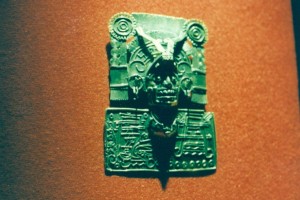 had joined our group in Oaxacaand taken us into the regional museum where many of the artifacts from Monte Albán and its famous Tomb B are kept. Although it had been a whirlwind tour of the museum and was proving equally fast through the archaeological site, his knowledge and enthusiasm brought the buildings alive.
had joined our group in Oaxacaand taken us into the regional museum where many of the artifacts from Monte Albán and its famous Tomb B are kept. Although it had been a whirlwind tour of the museum and was proving equally fast through the archaeological site, his knowledge and enthusiasm brought the buildings alive.
“Under here are tunnels through which the priests would walk in order to appear majestically and mysteriously over there” Adding as he pointed: “See that configuration of stones. 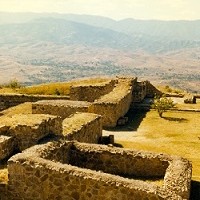 The sun can penetrate through on only one day of the year, the day when we believe the sowing of the fields was commenced. Now look at these carvings of human figures called “Los Danzantes”– are they really dancers or do they represent sick patients in hospitals, people with birth defects, or death portraits of criminals or captured enemies?” I was inclined to believe they represented patients and recalled reading of the Maya’s sophisticated knowledge of medicine.
The sun can penetrate through on only one day of the year, the day when we believe the sowing of the fields was commenced. Now look at these carvings of human figures called “Los Danzantes”– are they really dancers or do they represent sick patients in hospitals, people with birth defects, or death portraits of criminals or captured enemies?” I was inclined to believe they represented patients and recalled reading of the Maya’s sophisticated knowledge of medicine.
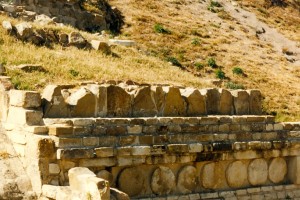 At the ball court (a long thin playing alley bounded by sharply vertical walls and with stone rings anchored to the side walls), Antonio invited us to imagine the spectators seated in the stone stands. The game of soccer is arguably the modern derivative of the ancient Mesoamerican ball game, although players in these games could only use their head, shoulders and hips. The losers, according to scenes carved in the stone at Chichén Itzá, were known to lose their heads.
At the ball court (a long thin playing alley bounded by sharply vertical walls and with stone rings anchored to the side walls), Antonio invited us to imagine the spectators seated in the stone stands. The game of soccer is arguably the modern derivative of the ancient Mesoamerican ball game, although players in these games could only use their head, shoulders and hips. The losers, according to scenes carved in the stone at Chichén Itzá, were known to lose their heads.
Above all, Antonio wanted me to get in touch spiritually with the site. Instead I made a sudden connection with him. Here was a young man passionate about his history having to escort tourists through such a sacred centre. Tourists who had maybe an hour or two: who would take their pictures, buy their souvenirs and move on. He looked at me speculatively. “We have to protect the secrets of Monte Albán” he said “As I walk I see places, but I cannot visit them with tourists or they would be destroyed. There is so much more to be discovered here. And I believe that each time we find something new we challenge history– it will be rewritten many times with the findings of Monte Albán”.
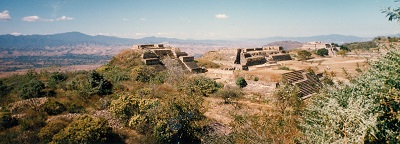 I climbed up to the top of the south platform where the high priests would have stood. Butterflies swarmed around me as I sat down and tried to visualize all the activity that would have been taking place below when Monte Albán was at its greatest: before the Mixtecs turned it into a site for burial tombs; before it became part of the mighty Aztec empire; and long before the Spanish Conquistadores arrived.
I climbed up to the top of the south platform where the high priests would have stood. Butterflies swarmed around me as I sat down and tried to visualize all the activity that would have been taking place below when Monte Albán was at its greatest: before the Mixtecs turned it into a site for burial tombs; before it became part of the mighty Aztec empire; and long before the Spanish Conquistadores arrived. 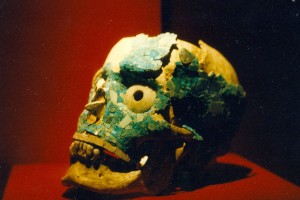 During those years its decline coincided with major political upheavals, the valley was divided into smaller communities, and with the introduction of Eurasian diseases, the population of the valley was decimated. I took out my replica, my genuine Mayan carving, and watched Antonio as he walked back to the north platform, passing the Oaxacan artisan on his way. The spirit of the Zápotecs is still very much alive.
During those years its decline coincided with major political upheavals, the valley was divided into smaller communities, and with the introduction of Eurasian diseases, the population of the valley was decimated. I took out my replica, my genuine Mayan carving, and watched Antonio as he walked back to the north platform, passing the Oaxacan artisan on his way. The spirit of the Zápotecs is still very much alive.
For more information visit www.oaxaca.travel and www.visitmexico.com See also our tv feature on Oaxaca.


